
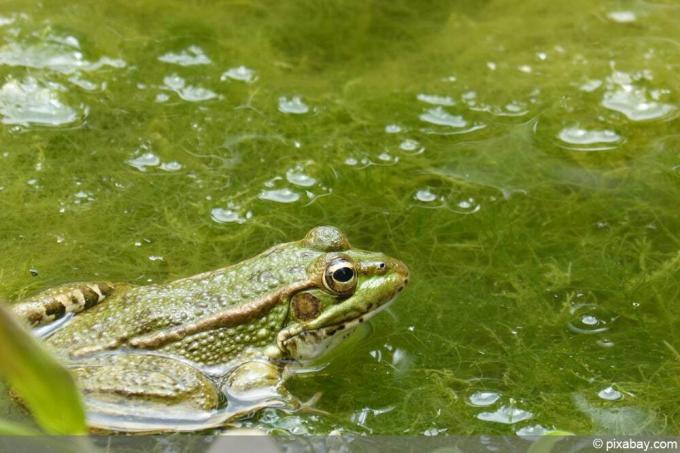
Table of contents
- Pond fish as algae eaters
- Grass carp (Ctenopharyngodon idella)
- Mustache (Leucaspius delineatus)
- Rudder (Scardinius erythrophthalmus)
- Silver carp (Hypophthalmichthys molitrix)
- Pennant carp (Myxocyprinus asiaticus)
- Alleged algae eaters in the garden pond
- What else helps: mollusks and crustaceans
Excessive growth of algae in the pond is not only an optical problem, but also causes considerable problems within the mini ecosystem. In addition, the green plague is difficult to remove, which is why many pond owners are only too happy to resort to the support of algae-eating fish. You can read in our article which species that are frequently offered actually eat algae and which do not meet this expectation.
Pond fish as algae eaters
Sometimes, however, all precautionary measures and the most beautiful planting do not help. In this case, the five fish species listed here do well both as algae killers and as ornamental fish in the garden pond. However, you shouldn't expect these species to completely eliminate algae growth and the water becomes clear again on its own: this is also possible with outspoken ones Algae Killer Fish don't. Here, too, only a combination of eliminating the cause, suitable pond planting and well-considered stocking of fish can help.
Grass carp (Ctenopharyngodon idella)
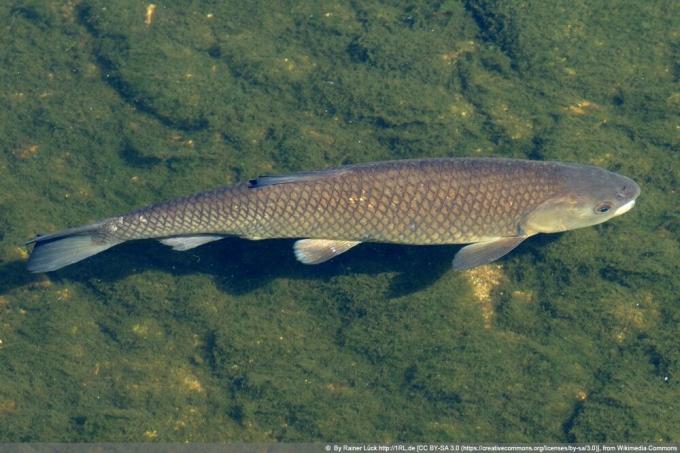
The large and heavy grass carp are very suitable for fighting algae because they feed exclusively on algae and other underwater plants. But be careful: Due to their size, they are only suitable for really large garden ponds. Also make sure that the planting is very lush, as these fish are insatiable and, if there is a lack of food, like to eat ornamental plants or the vegetation on the bank. If necessary, top up with freshly cut grass.
- Size / Length: up to 120 centimeters, up to 40 kilograms in weight
- Lining: aquatic plants, algae
- propagation: from temperatures of 20 °C, multiply very quickly
- pond size: at least 20 square meters per fish
- water quality: high oxygen content, good for this are waterfalls, fountains and/or streams
Mustache (Leucaspius delineatus)
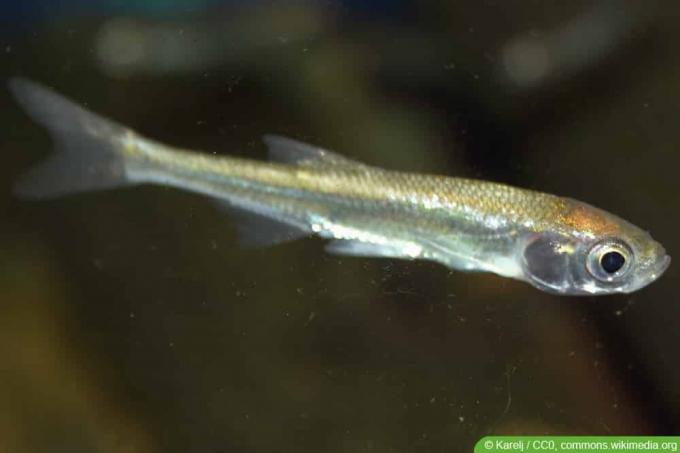
The local mildew is also an algae-eating fish species with an almost gigantic appetite. The small, silvery fish are also easy to observe, as they usually swim just below the surface like to hide between the water plants and occasionally mosquitoes buzzing just above the water surface to hunt.
- Size / Length: up to about 10 centimeters
- Lining: Phyto- and zooplankton, algae, mosquitoes
- propagation: Water temperatures above 18 °C, oviposition on aquatic plants
- Group size: Schooling fish, at least 10 to 12 fish
- pond size: at least 2000 liters
- pond depth: at least 80 centimeters (for winter storage! pond must not freeze through)
- water quality: high oxygen content, low nitrate content
Rudder (Scardinius erythrophthalmus)

Rudder are also busy algae eaters and are therefore well suited for destroying algae growth. However, these pretty fish also like to eat other aquatic plants, which is why such a stock is quickly decimated and with a bit of bad luck you will no longer have any plants in the pond. It is best to prevent this with regular feeding and the preferred planting of aquatic and riparian plants with leathery, broad leaves. Red feathers prefer delicate, fine-leaved plants.
- Size / Length: 20 to 35 centimeters
- Look: red back, red fins
- Lining: Insects, zooplankton, small invertebrates, aquatic plants, algae
- propagation: in shallow water (approx. 20 centimeters deep)
- pond depth: at least 70 centimeters
- Group size: at least 5 pieces, at best 10 to 15 pieces
- water quality: oxygen rich, easy flow, filter and pump necessary
Tip:
You can estimate the water quality based on the color of the back and fins of the rudd: If this is good and the water is rich in oxygen, the species-typical red coloration is particularly strong. However, it fades when the water quality is poor, which you should take as an alarm signal - the sensitive fish then die quickly and algae growth is also encouraged.
Silver carp (Hypophthalmichthys molitrix)
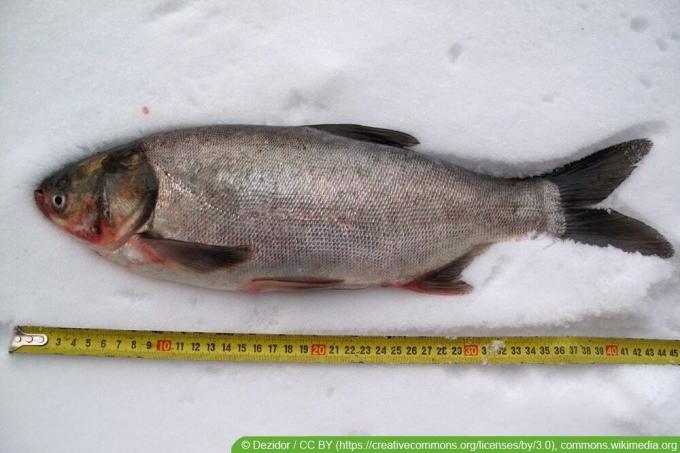
The silver carp, which can grow up to one meter long in the wild, has become a problem in some waters due to its voracity. Once exposed to combat algae, it also eats other aquatic plants when there is a lack of food - which results in bare lakes and ponds and the resulting lack of oxygen. So always make sure that the quaint fish always have enough to eat and feed them if necessary.
- Size / Length: up to 60 centimeters
- Lining: Phytoplankton, good algae eater
- Group size: at least four animals
- pond size: at least 20,000 liters
- pond depth: at least 80 centimeters, preferably more
- water quality: high oxygen content, stagnant to easy-flowing water
Pennant carp (Myxocyprinus asiaticus)
The Chinese pennant carp – sometimes referred to as batfish because of its characteristic appearance – is also a very good algae eater. However, like all carp, it is only suitable for large garden ponds and also has very specific water quality requirements. In contrast to many other pond fish, this species needs water that is as clean and low in nitrate as possible and has a slightly acidic pH value. If you want to keep pennant carp, you should ensure that these requirements are met, otherwise the animals will quickly get sick and die.
- Size / Length: usually 40 to 60 centimeters, in exceptional cases more
- Lining: Phytoplankton, good algae eater
- Group size: at least five animals, good to socialize with Koi
- pond size: at least 20,000 liters
- pond depth: at least 80 centimeters, preferably more
- water quality: high oxygen content, low-nitrate water, pH slightly acidic to neutral
Alleged algae eaters in the garden pond
Various types of fish are presented as ideal “algae eaters” on the Internet and in stationary specialist shops. advertised, which keep the garden pond free of annoying algae and thus the water clear and clean would. Unfortunately, this is a nice pipe dream, but it doesn't work in practice. Some of the “water-cleansing” fish hardly eat any algae or are not at all suitable for the garden pond because they need completely different living conditions.
These fish species are considered algae-eating, but they are not, for a variety of reasons:
- Nose(Chondrostoma nasus): native of (strongly) flowing waters
- golden minnow(Pimephales promelas): eats mainly insects, water fleas, small crustaceans
- gudgeon(Gobio gobio): eats crabs, worms and other small animals from the bottom of the pond
Tip:
The best way to keep your garden pond free of algae is to combat the causes of algae growth. These include, above all, a high nutrient content in the water (e.g. B. fertilizers washed away by seepage water from the neighboring lawn) and a high water temperature. The latter can be avoided by shading the water surface, for example with the help of taller water and bank plants.
What else helps: mollusks and crustaceans

In addition to fish, water snails, pond mussels and local crustaceans also like to eat algae. These species in particular are often kept in the garden pond for this purpose:
- European freshwater shrimp (Atyaephyra desmaresti)
- Small swamp snail (Galba truncatula)
- ramshorn snail (Planorbarius corneus)
- pointed mud snail (Lymnaea stagnalis)
- Swamp Lid Snail (Viviparidae)
- pond shell (Anodonta cygnea)
But beware:
In good conditions, the little animals multiply very quickly, which can quickly lead to a lack of food. As a result, they eat not only the unwanted algae, but also other, desirable aquatic plants. You should therefore not allow the stocking to become too large and, if necessary, fish out excess snails.
 Home editorial office
Home editorial office
Learn more about algae in the pond
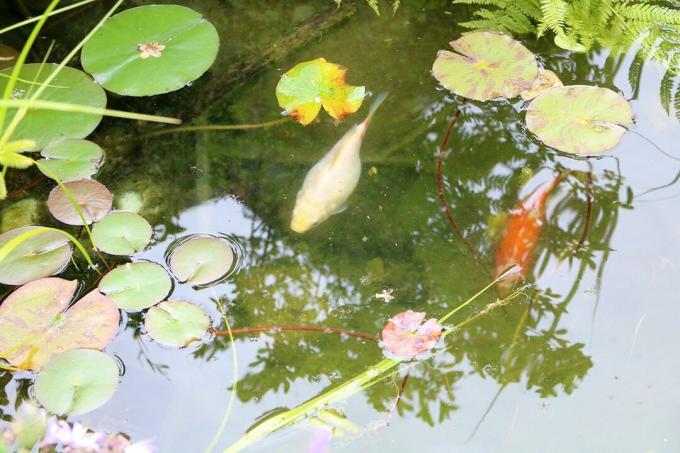
Floating algae in the pond: 10 tips for removing them
Algae infestation is not only unsightly to look at, but can also pose a threat to aquatic animals and plants. For this reason, it is advisable to always remove floating algae - read here how this works best!
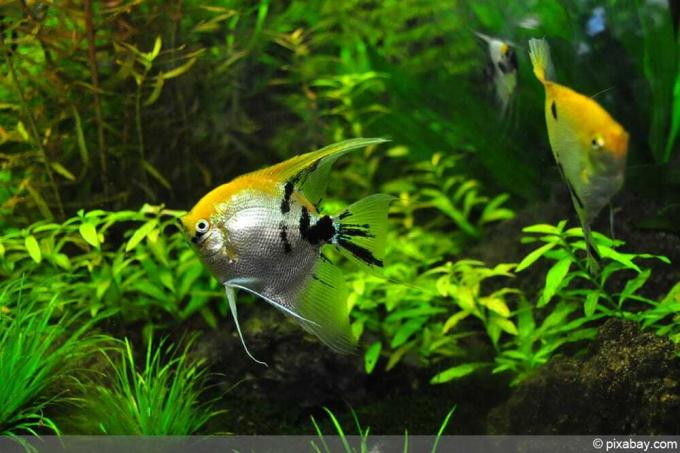
Combat thread algae in the aquarium
The right countermeasures must be taken at an early stage to ensure that the thread algae in the aquarium do not grow too rampant and become a nuisance. Otherwise, the aquatic plants can severely disturb the sensitive ecosystem of the aquarium and also negatively affect the visual appearance.
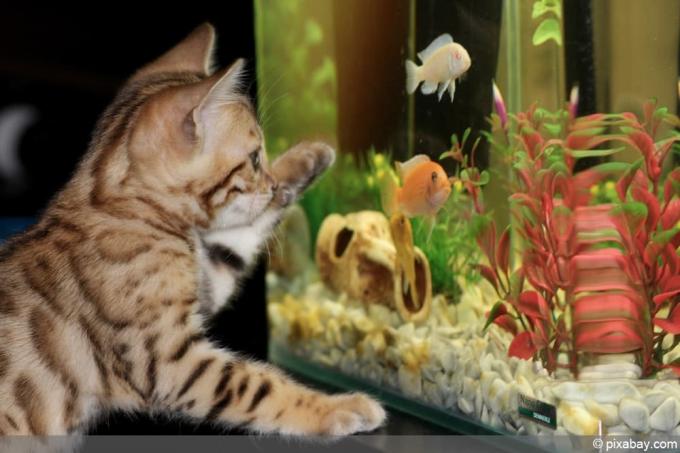
Get rid of green algae in the aquarium properly
Green algae occur in every aquarium. This is normal and part of it. It can even speak for a particularly good water quality. Only a massive increase in algae caused by too much light and too many nutrients is not normal. The green coloring and turbidity of the water means nothing other than that the biological balance has gotten out of joint. There are different green algae, also with quite different requirements. However, all benefit from an excess of food and can best be combated by depriving them of food.
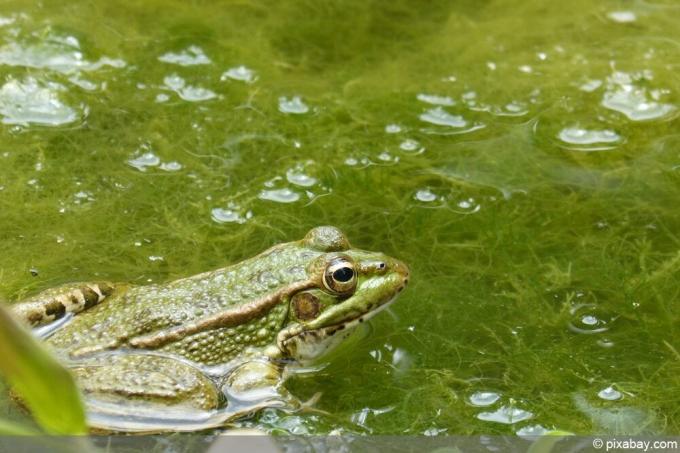
Natural remedies against thread algae
Algae in the garden pond are an absolute nuisance, but can hardly be avoided. Besides, they are useful too. They serve as food for microorganisms and also produce vital oxygen. It gets annoying when they multiply en masse.

The best home remedies for algae in the aquarium
Algae in the aquarium are absolutely natural and normally do not have to be fought. It only becomes difficult when they multiply explosively. There is a reason for this increase. It has to be found and turned off. That sounds simple, but it isn't.

Combat diatoms in the aquarium - in 5 steps
Diatoms occur mainly in newly set up freshwater and seawater aquariums, but can also appear during normal aquarium operation. This is mainly due to the initially high concentration of silicates.



